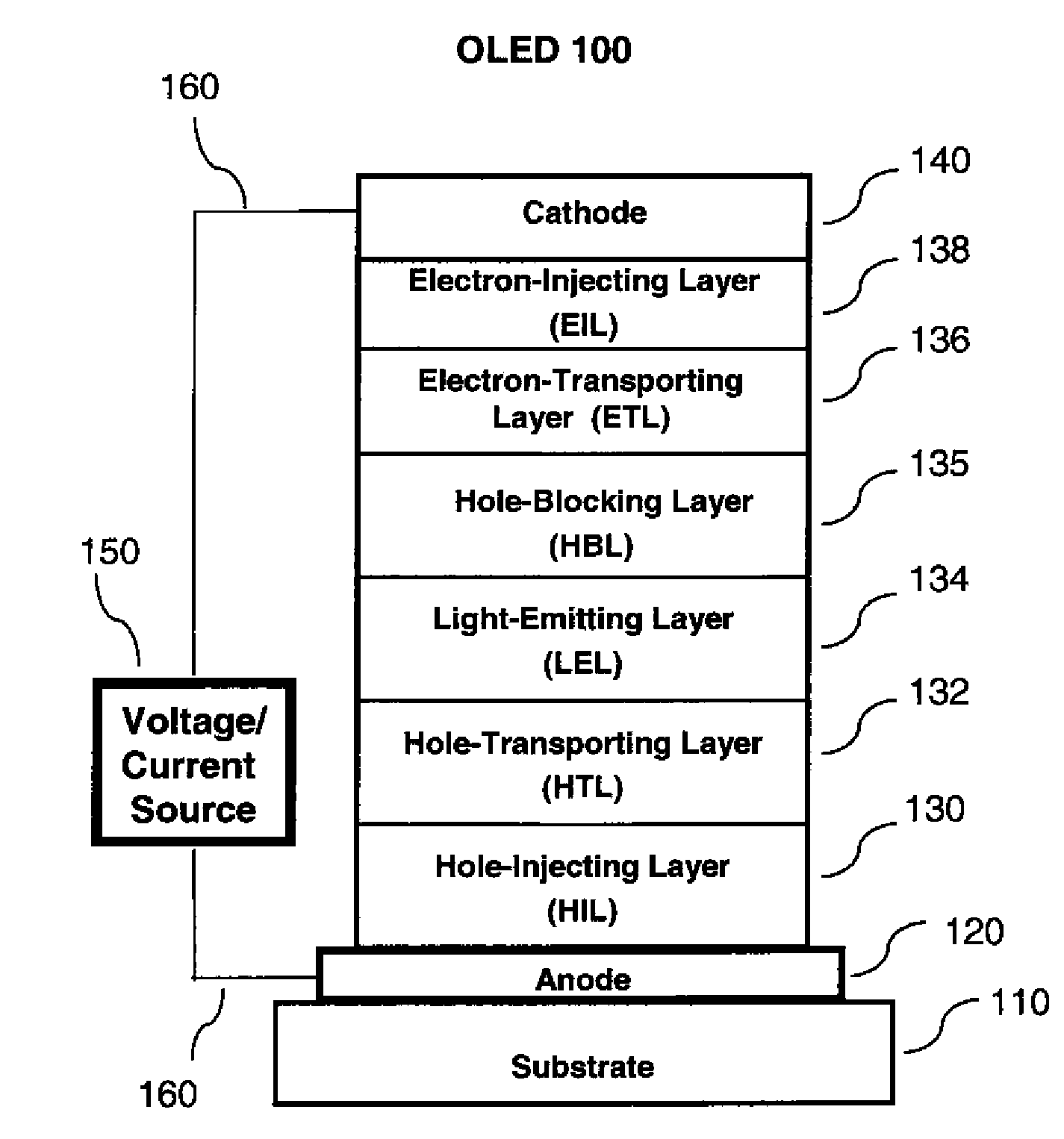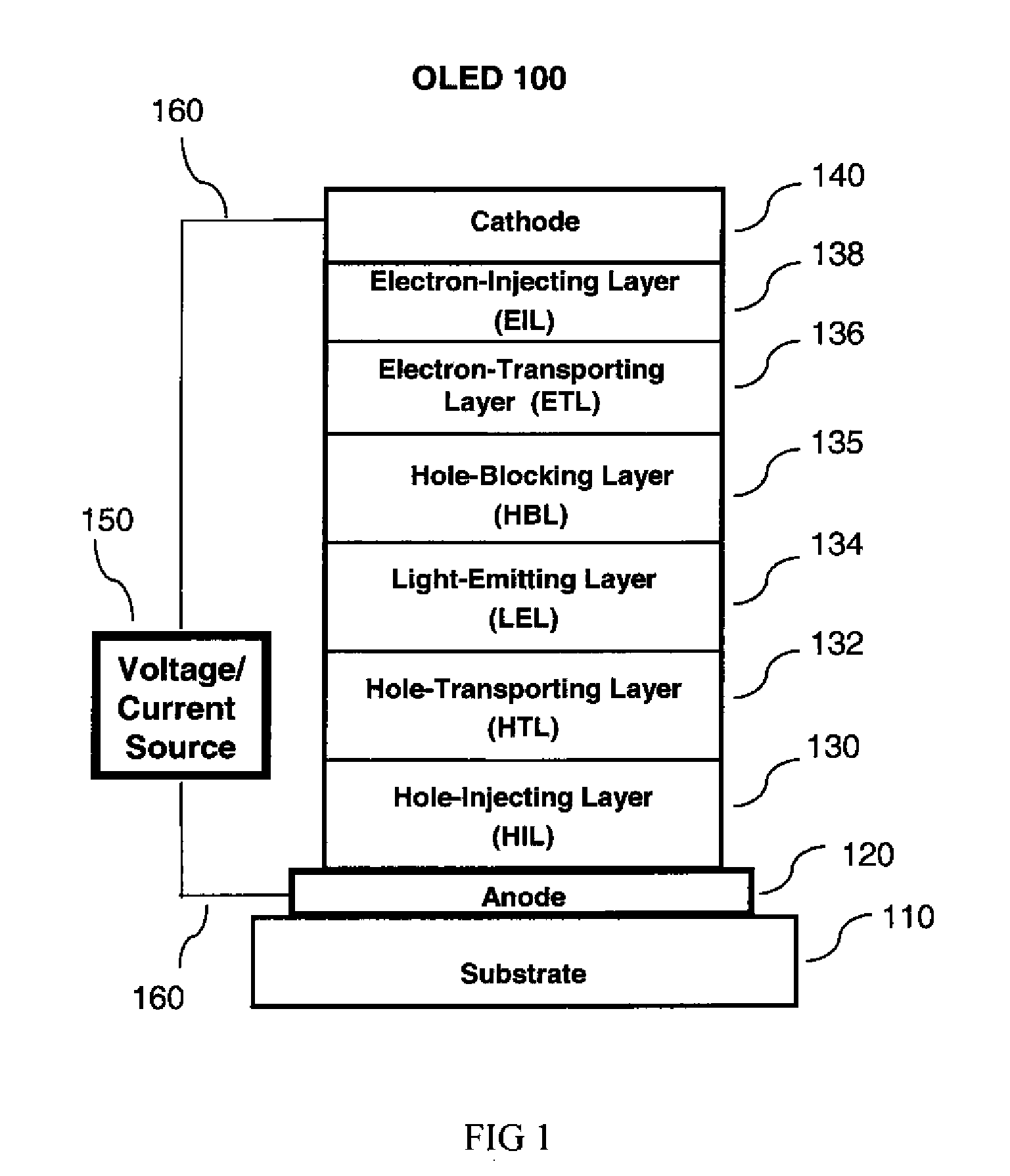OLED device with fluoranthene electron injection materials
- Summary
- Abstract
- Description
- Claims
- Application Information
AI Technical Summary
Benefits of technology
Problems solved by technology
Method used
Image
Examples
example 1
Synthesis of Inventive Compound Inv-1
[0331]Inv-1 was synthesized as outlined in Scheme 1 and described below.
Preparation of 7,9-Diphenyl-8H-Cyclopent[a]acenaphthylen-8-one (1)
[0332]7,9-Diphenyl-8H-Cyclopent[a]acenaphthylen-8-one, (Acecyclone), (1) was prepared according to the procedure of W. Dilthey, I. ter Horst and W. Schommer; Journal fuer Praktische Chemie (Leipzig), 143, (1935), 189-210.
Preparation of 8-pyrid-3′-yl-7,10-diphenylfluoranthene (Inv-1)
[0333]Acecyclone (5.6 g, 16.0 mMol) and 2-ethynylpyridine (2.16 g, 21 mMol) were heated in 1,2-dichlorobenzene (50 mL) at 200° C. for 3 hours. After this period, the solution was cooled and added directly to a column of silica gel. Using pressure chromatography and eluting initially with heptane, 1,2-dichlorobenzene was removed. A gradient of ethyl acetate / heptane up to 50% ethyl acetate was then used to obtain a solution of product. After removal of most of the solvent (heptane / ethyl acetate) by evaporation, the product began to cry...
example 2
Electrochemical Redox Potentials and Estimated Energy Levels
[0334]LUMO and HOMO values are typically estimated experimentally by electrochemical methods. The following method illustrates a useful way to measure redox properties. A Model CHI660 electrochemical analyzer (CH Instruments, Inc., Austin, Tex.) was employed to carry out the electrochemical measurements. Cyclic voltammetry (CV) and Osteryoung square-wave voltammetry (SWV) were used to characterize the redox properties of the compounds of interest. A glassy carbon (GC) disk electrode (A=0.071 cm2) was used as working electrode. The GC electrode was polished with 0.05 μm alumina slurry, followed by sonication cleaning in Milli-Q deionized water twice and rinsed with acetone in between water cleaning. The electrode was finally cleaned and activated by electrochemical treatment prior to use. A platinum wire served as counter electrode and a saturated calomel electrode (SCE) was used as a quasi-reference electrode to complete a ...
example 3
Preparation of Blue-Light Emitting OLED Devices 3.1 through 3.6
[0339]A series of OLED devices (3.1 through 3.6) were constructed in the following manner:
[0340]1. A glass substrate coated with an 85 nm layer of indium-tin oxide (ITO), as the anode, was sequentially ultrasonicated in a commercial detergent, rinsed in deionized water and exposed to oxygen plasma for about 1 min.
[0341]2. Over the ITO was deposited a 1 nm fluorocarbon (CFx) hole-injecting layer (HIL) by plasma-assisted deposition of CHF3 as described in U.S. Pat. No. 6,208,075.
[0342]3. Next a layer of hole-transporting material 4,4′-Bis[N-(1-naphthyl)-N-phenylamino]biphenyl (NPB) was deposited to a thickness of 95 nm.
[0343]4. A 20 nm light-emitting layer (LEL) corresponding to the host material P-4 and 1.5% by volume of FD-54 was then deposited.
[0344]5. An electron-transporting layer (ETL) consisting of a mixture of isomeric compounds FA-2 and FA-3 (60 / 40 ratio) at a thickness as shown in Table 2, was vacuum-deposited ov...
PUM
| Property | Measurement | Unit |
|---|---|---|
| Thickness | aaaaa | aaaaa |
| Energy | aaaaa | aaaaa |
| Electric potential / voltage | aaaaa | aaaaa |
Abstract
Description
Claims
Application Information
 Login to View More
Login to View More - R&D
- Intellectual Property
- Life Sciences
- Materials
- Tech Scout
- Unparalleled Data Quality
- Higher Quality Content
- 60% Fewer Hallucinations
Browse by: Latest US Patents, China's latest patents, Technical Efficacy Thesaurus, Application Domain, Technology Topic, Popular Technical Reports.
© 2025 PatSnap. All rights reserved.Legal|Privacy policy|Modern Slavery Act Transparency Statement|Sitemap|About US| Contact US: help@patsnap.com



